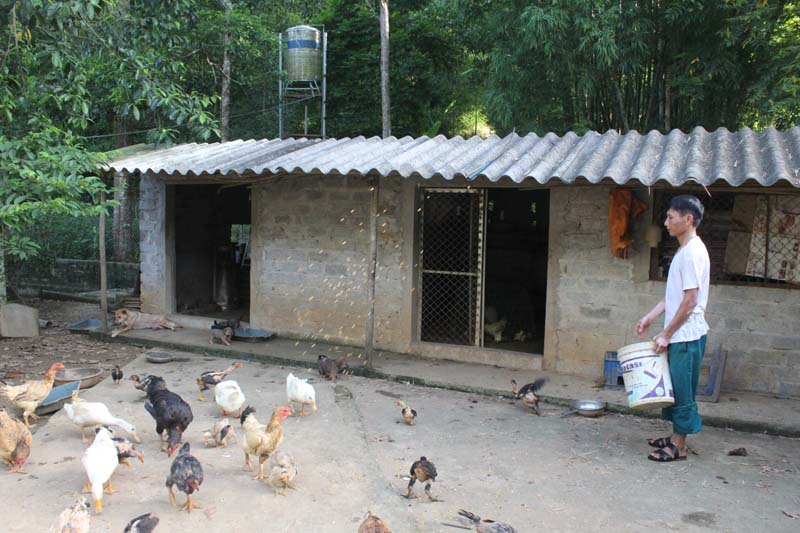
(HBO) – Being a commune with a convenient traffic system and relatively flat terrain, Dan Hoa commune (Ky Son) has many advantages for socio-economic development. In addition, it has favorable climate conditions for agricultural development towards diversification of crops. At present, there are 16 enterprises operating in the commune, creating jobs for many local workers. The commune has abundant human resources, having experience in production and manning, which is a great resource to exploit the land potential for economic development.

From Social Policy Bank loans, local people
in Tan Lap Village, Dan Hoa commune (Ky Son) invest in raising chickens to
develop family economy.
On the basis of these advantages, by using
the most of production land, the commune's economy has achieved remarkable
results. Up to now, the per capita income of the commune has reached at over
VND 31 million per year. The rate of poor households has reduced to 4.46%, the
near poor ones has reduced to 7.67%. One significant resource that helps Dan
Hoa commune to reduce poverty and increase incomes is the source of credit
capital for poor households and policy beneficiaries.
With the investing form of lending directly
to households, the preferential credit sources have effectively served the
development of agricultural and rural economy and the development of
small-scale industries. From loans, the households invested in planting fruit
trees, raising cattle, poultry and bee breeding, and planting trees with high
economic value. This preferential credit investment for hunger eradication and
poverty reduction (HEPR) programs not only achieved economic efficiency but
also affected to the change of awareness of poor households, helping them to
mobilize themselves to escape from poverty and stepping up to enrich. Although
being a relatively developed area, leaders of Dan Hoa commune always considered
poverty reduction as the key task of the commune. Hence, the credit capital for
poor households plays a particularly important role in poverty reduction
activities in the locality. Up to now, Dan Hoa commune has 9 savings and loan
groups, 347 households borrowing capital with the total debt of nearly 6
billion VND. The process of reviewing and selecting loans is public,
democratic, with the participation of mass organizations, commune and village
leaders to ensure the loan level to be suitable with capital requirements of
the production plans.
The emulation movement "Hoa Binh joining hands to build new-style rural areas” has been widely spreading, becoming a driving force that motivates the localities to renew rural landscapes and improve the material and spiritual lives of the residents. In this movement, the people play a central role-both as the main implementers and direct beneficiaries of its outcomes.
In response to the global digital revolution, Hoa Binh Newspaper is transforming itself into a modern and multi-platform media hub, blending cutting-edge technology with a restructured newsroom and a new generation of tech-savvy journalists.
Hoa Binh province’s Association of the Elderly recently held a conference to review the project on expanding the inter-generation self-help club model until 2025.
In a move to implement Resolution No. 57-NQ/TW, issued on December 22, 2024 by the Politburo, which targets breakthroughs in science-technology development, innovation, and digital transformation, the Hoa Binh provincial Department of Health has issued a plan to roll out the "Digital Literacy for All” campaign within the local health sector.
An Nghia Commune (Lạc Sơn District) is one of the communes that achieved the tha standard of the national new rural area in 2018. Entering a new development phase, the commune is now trying to meet the criteria for the advanced new rural development. With the strong political will and the public consensus, the commune is gradually overcoming the challenges to reach this goal, aiming for the sustainable development.



